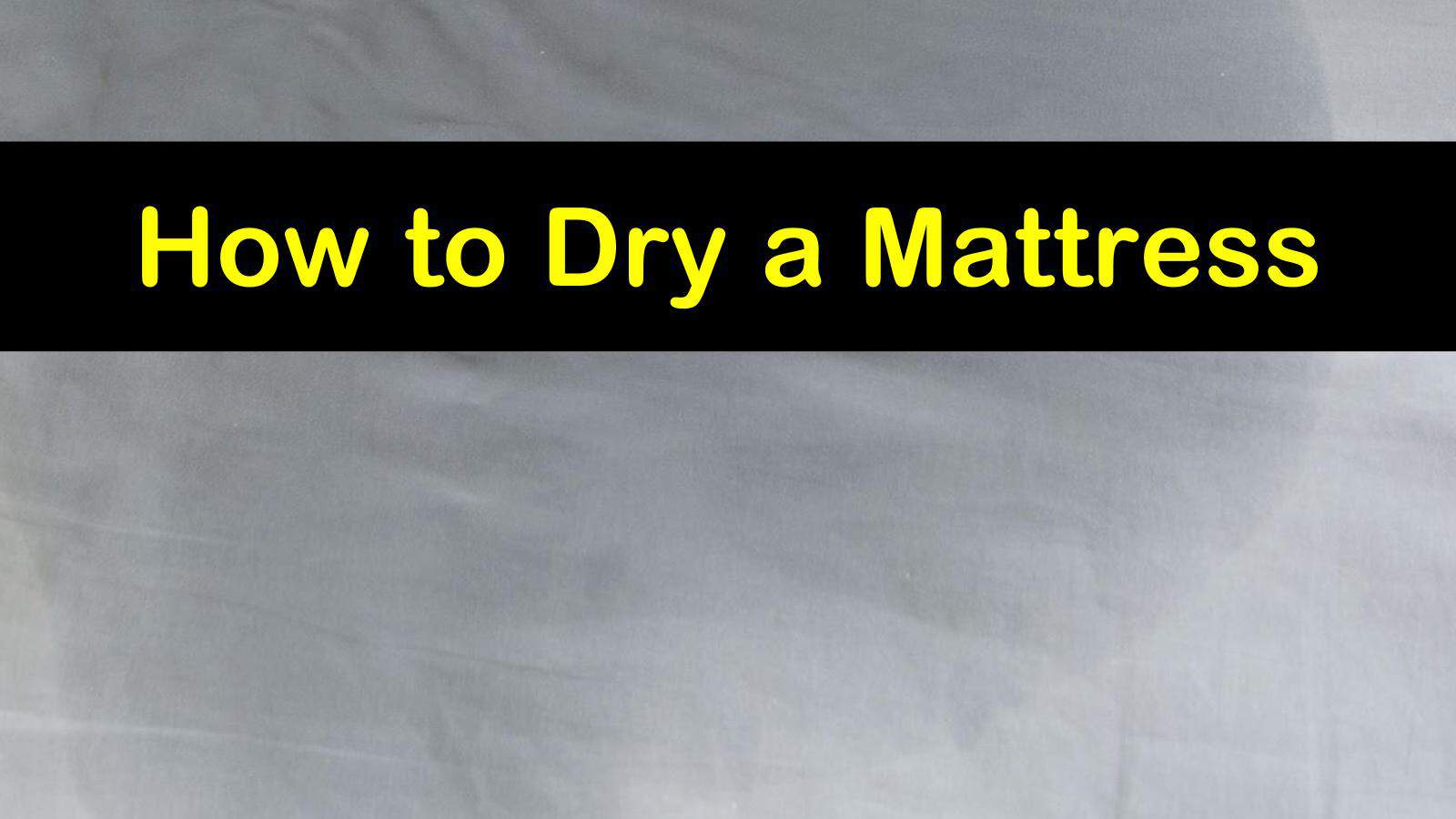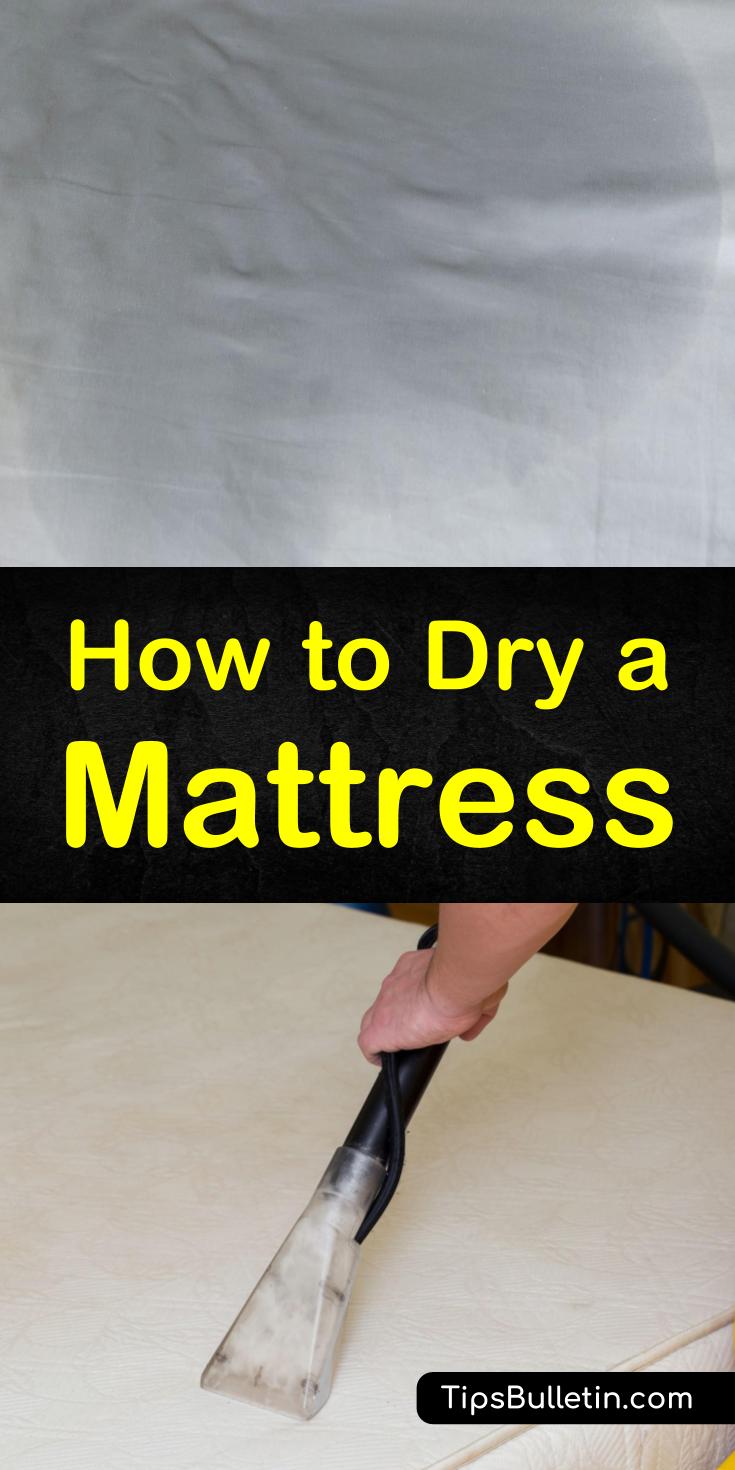One thing you need to ask yourself when learning how to dry a mattress is how the bed got wet in the first place. It is crucial to understand how the mattress got wet to figure out if the mattress is worth drying, as some mattresses, even after they dry, cannot be used again.
The best example of an unsalvageable mattress is one suffering from water damage due to floods. Floodwaters contain all sorts of toxic substances, including fuel and biohazards, so there is no possible way to thoroughly sanitize the mattress to ensure it is safe to use.
If your mattress is wet from some other reason, such as spilled drinks, somebody wet the bed, etc., it is salvageable, but you must dry it quickly and thoroughly. A damp or soggy mattress not only takes on a musty smell, but mold and mildew may also start to grow if it is not dried correctly.

Easy and Effective Ways for Drying a Mattress
After cleaning memory foam or a standard mattress, you need to take care how you dry it so that it is ready to sleep on again. Drying a mattress isn’t hard as long as you remember to follow a few simple guidelines.
How to Dry a Mattress with a Hairdryer
If the wet spot on bed is small, cleaning up and drying the place is simple. Begin by soaking up as much excess liquid as possible. You can use paper towels or absorbent towels.
When soaking up excess moisture, apply firm pressure, as you are forcing the liquid out of the mattress. As the towels become saturated, replace them with dry ones. Continue using new dry towels until you have soaked up as much liquid as possible.
Depending on what spilled on your mattress, you may have to use a stain remover. Pure water doesn’t require a stain remover, but here is a handy stain eliminator that works on a variety of stains.

Mix dish soap and hydrogen peroxide and apply directly to the stain to not only eliminate the stain but for how to get rid of urine smell in a mattress. Use a toothbrush or scrub brush to work the stain remover into the mattress. Allow to soak for five minutes and then wipe with a damp cloth.
Once the stain is gone, pull out your hairdryer to dry the mattress. Aim the hairdryer at the wet spot and use a warm setting rather than a hot one. Keep the hairdryer moving a few inches above the bed and dry for 20 minutes.
Allow the wet spot to cool and check to see if it’s dry. If not, continue using the hairdryer for another ten minutes. If it’s still not dry, proceed to a different drying method like bringing the mattress outdoors or using a fan directly on the mattress.
How to Dry a Wet Mattress with Urine Stains
How to dry a wet mattress with urine stains is the same as drying any other bed. The difference is that you need to use an enzyme cleaner or urine stain remover to ensure the removal of all urine.
Make a cleaning solution by combining equal parts warm water with white vinegar inside a spray bottle. Soak up urine with a clean cloth. Spray the urine stain with the cleaning solution and allow it to sit for five minutes. Blot the solution to clean up as much liquid as possible.
Never rub the stain, as that can force the stain further down into the mattress. Repeat with the cleaning solution until you get urine out of the mattress. If you are drying the mattress inside, offer plenty of air movement to aid in the drying process.
You can also use this vinegar stain remover to clean throw up off a mattress. Vomit also leaves a strong and unwanted smell, so be sure to use the same methods to get throw up smell off a mattress.
Open windows, set up fans, or even use a dehumidifier to maximize airflow. Drying time varies based on how wet the mattress is. In some cases, it may take up to 24 hours to dry thoroughly. Once dry, consider adding a mattress protector or mattress cover to protect your mattress from future spills or accidents.
Drying a Mattress with Fans
If the area you are drying is large, use towels to soak up the excess moisture, but you will use quite a few of them. Instead of using rags, try absorbent kitty litter. Generously sprinkle the cat litter across the wet surface and then apply pressure to begin soaking up the moisture.
Apply pressure directly to the litter, or you can cover it with a rag first. Apply direct pressure for about five minutes and then walk away and allow the moisture to soak up into the cat litter.
After about an hour, come back and apply some more pressure. After about five more minutes, use a wet/dry vacuum and suck up the litter. If the mattress is still wet, apply fresh litter, and repeat the steps above.
Place the mattress on its side in an area that allows for two feet of space on each side. Position a fan at one end of the bed and turn on high. Aim the fans in a way that air is blowing on both sides at the same time.
Alternatively, you can use two fans; each one pointed directly at the side of the mattress. You can also open windows and turn on ceiling fans for maximum airflow, which will aid in the drying process.
How to Dry Memory Foam Mattress
Drying a memory foam mattress is similar to drying all other beds, as well as the best way to dry a foam mattress topper. If the liquid spilled creates a stain, use a homemade stain remover before you finish drying the mattress.
Use a wet/dry or shop vacuum to suck up as much excess moisture as you can or use a rag to sop it up; never try to wring the liquid from the foam mattress as this can cause irreparable damage. Use long, even strokes over the wet areas. If necessary, apply a foam mattress stain remover to the area.
Mix the three ingredients in a bowl and pour into a spray bottle. Do not mix directly in a spray bottle as foaming will occur. Spray the stained area of the mattress with the solution.
Open the windows and turn on fans while you allow the stain remover to sit for one hour. Once the mixture has dried, the stain should be gone along with any odor. Another drying option is to bring the mattress outside and place it in direct sunlight.
Create a platform for the best air circulation, which aids in the drying process. You can also add fans to help speed things up. Do not bring the mattress inside until it is fully dry. You would rather over dry it than to bring it in with the interior still being slightly damp.
Other Mattress Drying Tips
To prevent mold growth, use a solution of equal parts rubbing alcohol and water. Wipe the surface of the mattress with the solution and then allow it to dry using any of the above drying methods. Air out your mattress every couple of months by removing the sheets and mattress pad.
Open the shades and let sunlight in to kill any bacteria lurking within. This is a great way to dry and disinfect a used mattress. Sometimes, though, cleaning and drying a mattress is beyond your abilities, as the underlying cause was more than you bargained for, or it is just costly. Either way, you can call a professional restoration company to take care of your mattress for you.
They specialize in water damage and can save you from having to buy a new mattress. They have the ability and knowledge to clean, sanitize, and dry a variety of mattresses. To clean an old mattress, as well as help aid in moisture removal, sprinkle baking soda on your mattress.
Lightly sprinkle baking soda over the entire mattress surface in an even layer. Allow it to sit on the bed for at least 30 minutes, but you can leave it on as long as 24 hours.
To clean up the baking soda, use your vacuum cleaner’s upholstery attachment. If your mattress is a double-sided one, flip it over and repeat the same process on the opposite side. Baking soda has the added advantage of being a great DIY mattress deodorizer. If your mattress is a little musty, use baking soda to get rid of the odor.

Thank you for reading our tips on drying a mattress. If you found any of our mattress drying tips and ideas useful, please share these drying tips on Facebook and Pinterest so others can learn how to dry a mattress properly.